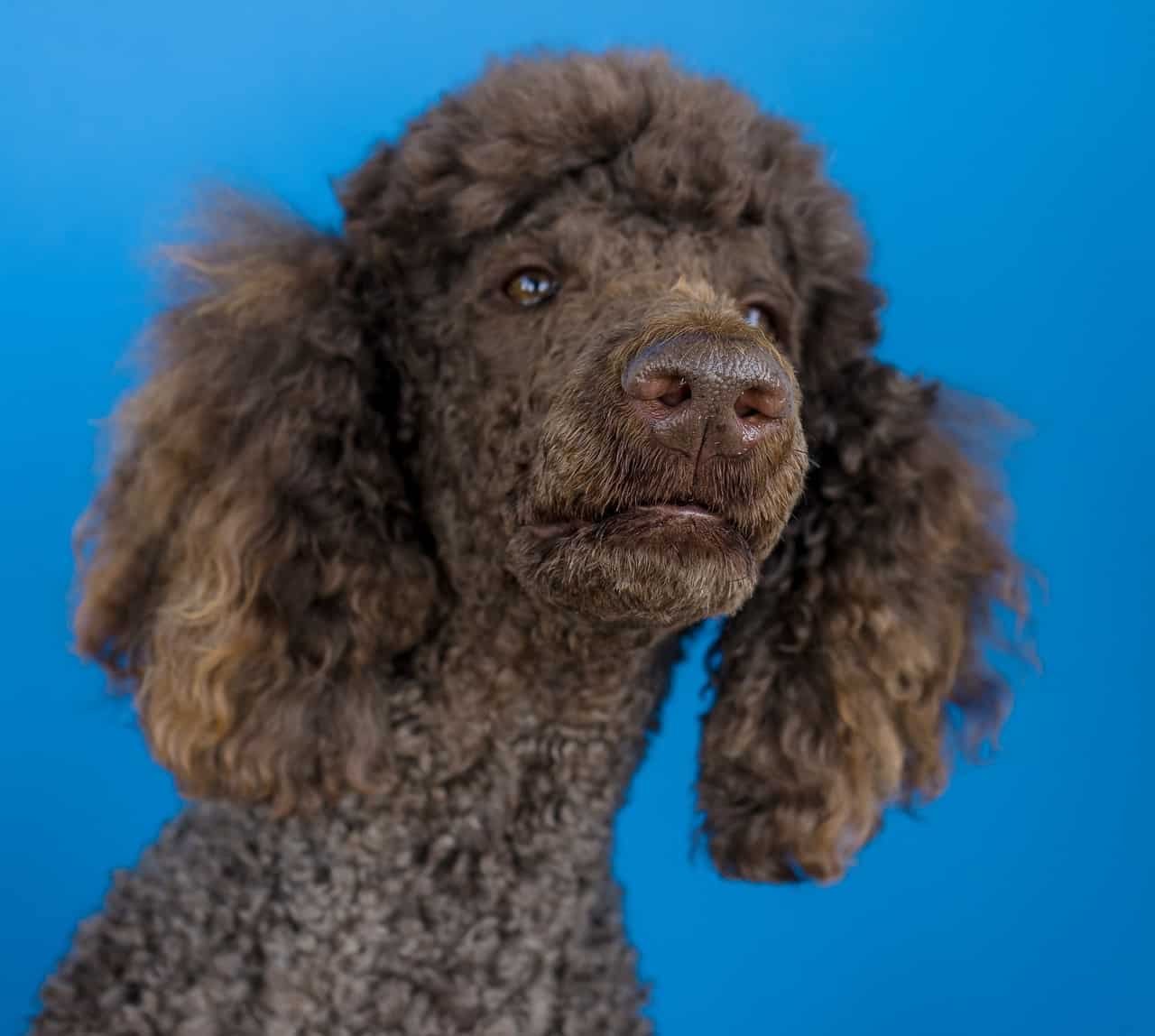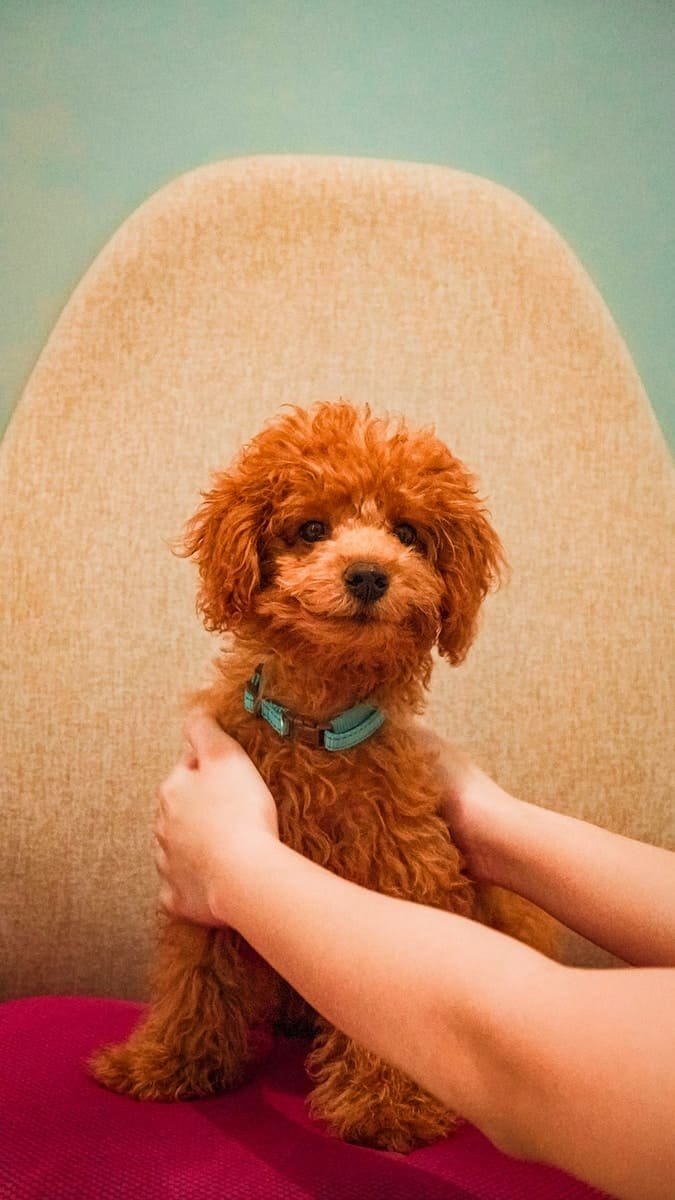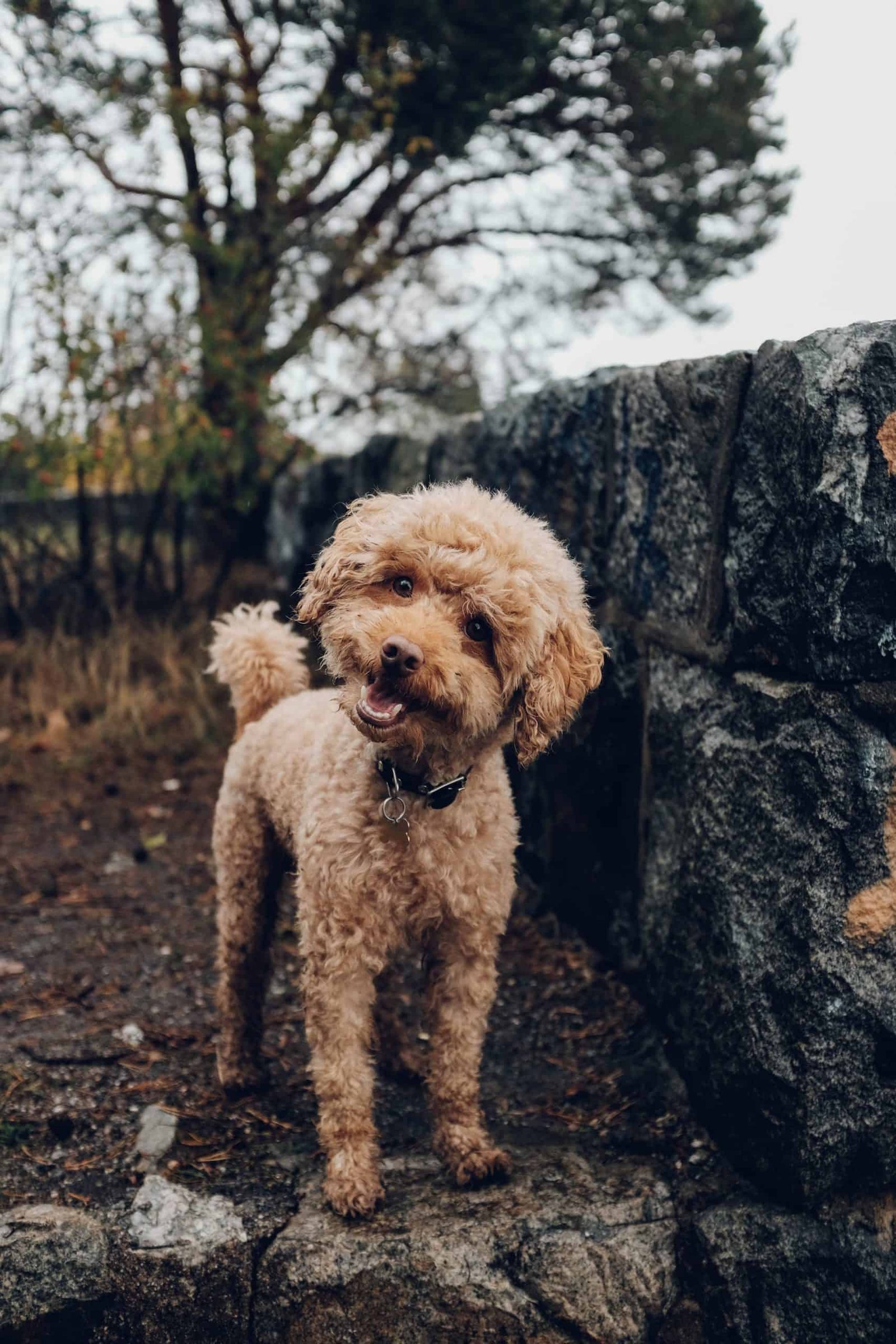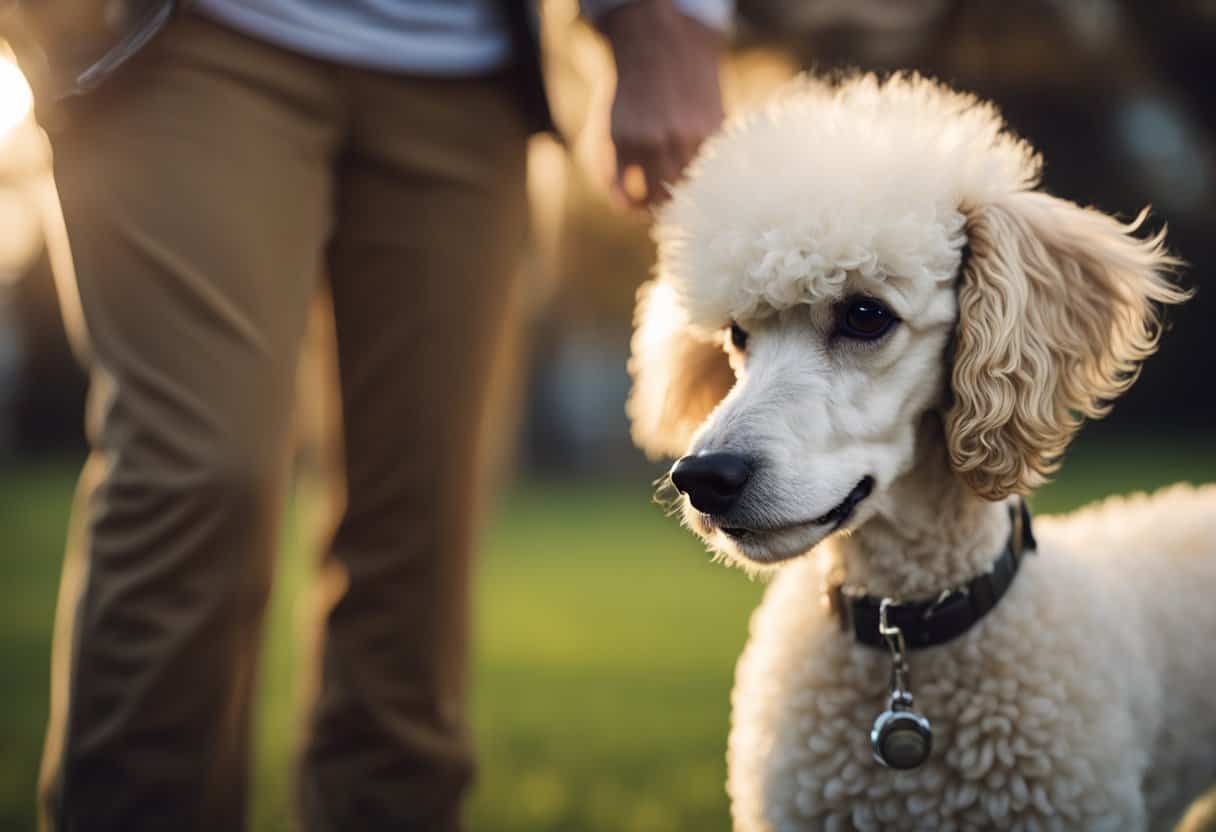
Understanding Poodle Affection
Quick Start: Follow these steps for best results with your poodle.

Poodles are known for their intelligent and expressive nature, forming deep bonds with their owners. To understand how your Poodle shows their affection, observe their body language and behavior.
Last Updated: November 2025 · This article has been reviewed and updated to ensure accuracy and relevance.
Tail Wagging: Your Poodle may express joy through enthusiastic tail wagging. This is a clear sign of their happiness and emotional state when they see you.
Cuddling and Nuzzling: Poodles seek physical closeness as a display of love and trust.
If your dog cuddles up or nuzzles against you, it’s their way of showing they feel safe and loved.
- Bringing Toys: A Poodle bringing a toy to you is not just an invitation to play—it’s a gesture of trust and a sign that they value your relationship.
Following You Around: Their inclination to follow you reflects their loyal and affectionate nature.
It shows their desire to be involved in your life and activities, a sign of unconditional love.
- Facial Expressions: Pay attention to a relaxed facial expression, which is an indication of trust and comfort in your presence.
While every Poodle is unique, these behaviors are commonly recognized as signs of affection. By understanding and reciprocating this emotional bond, you strengthen your relationship, enhancing the joy and love shared between you and your Poodle.
Common Signs of Poodle Affection
Recognizing the signs of affection from your Poodle is key to understanding and reinforcing your bond. They often use body language, physical contact, and vocalizations to express their emotions.
Tail Wagging and Body Language
Your Poodle’s tail wagging is a clear indication of their happiness and excitement to be around you. When your Poodle wags its tail with its body in a relaxed posture, it’s showing joy and contentment.
Pay attention to their overall body language; a relaxed stance with a gently wagging tail often means your Poodle feels safe and affectionate.
- Happy Tail Wagging: Broad, sweeping tail movements.
- Relaxed Body Posture: Soft eyes, loose stance.
Licking and Kissing
Poodles may lick your face or hands as a sign of affection, resembling what they did as puppies with their mother. This licking behavior often signifies they are comfortable with you and wish to show their love. If your Poodle gives you gentle licks, it’s akin to receiving a doggy kiss, which is a sign of trust and joy.
- Gentle Licking: Sign of affection and comfort.
- Kissing: Manifestation of love and happiness.
Cuddling and Snuggling
Physical contact is paramount for a Poodle expressing love. Cuddling and snuggling up to you is their way of getting close and enjoying your presence.
When your Poodle seeks out cuddles, it’s a sure sign they’re attached to you and enjoy the warmth and security you provide.
If they maintain eye contact while snuggling, it further indicates their trust and affection for you.
- Seeking Cuddles: Wanting physical closeness.
- Eye Contact: A strong sign of trust and love.
Social Behaviors Exhibiting Love
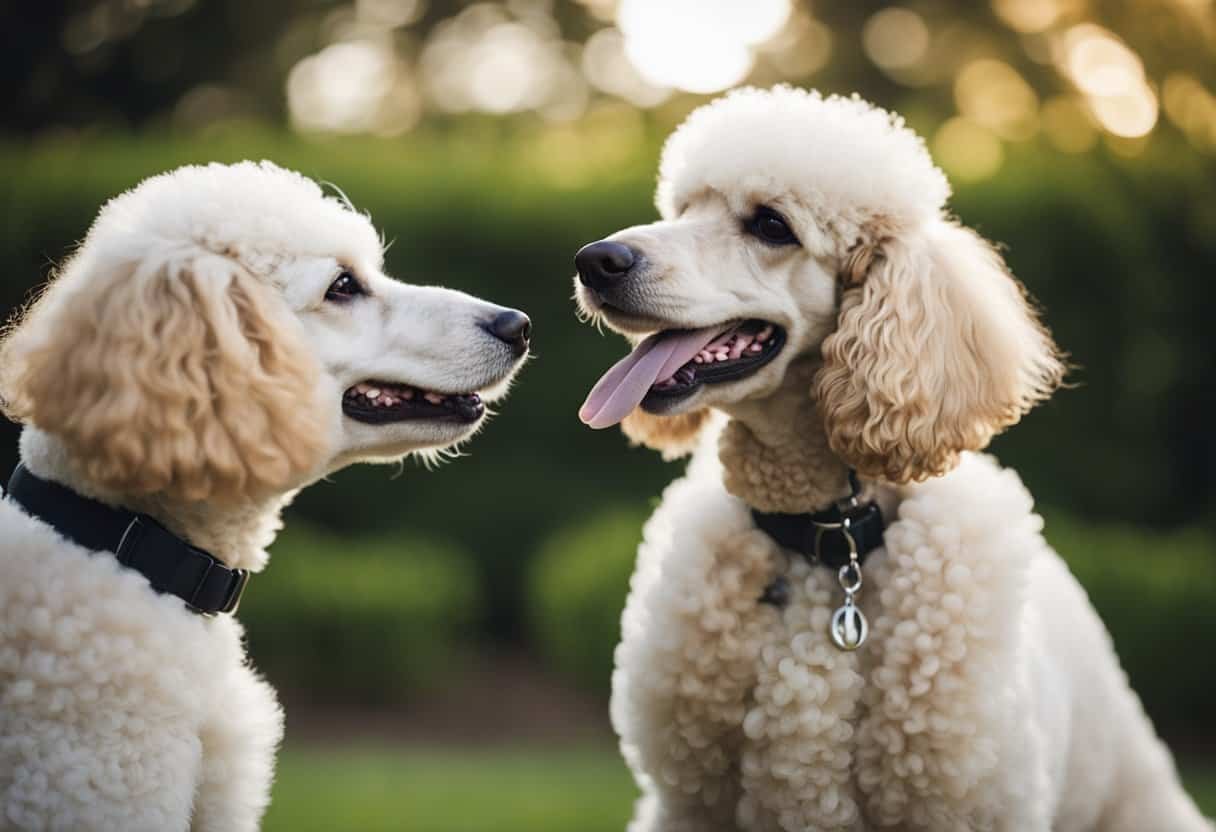
Poodles have unique ways to express their love that can be seen through various social interactions. Their communication extends beyond simple actions into a realm that can strengthen the bond between you and your pet.
Grooming as Affection
Grooming behavior is a genuine sign that your Poodle holds you dear.
When your Poodle carefully licks your hands or face, it’s not just a matter of hygiene – it’s intimacy.
This grooming is a love language, originated from their instinct to maintain social bonds with pack members.
- Grooming Actions:
- Licking your hands or face
- Nibbling gently to groom you
Following and Protectiveness
If your Poodle follows you around, it’s a sign of their loyalty and affection. This inclination to stay close and their desire to guard you are ways they convey their protective instincts.
Your Poodle’s follow-through in watching over you is their way of saying they care.
- Protective Behaviors:
- Following: Staying near you consistently
- Guarding: Display of vigilance in your presence
Playful Greetings
A Poodle’s excitement to see you is often shown through playfulness. Expect to be greeted with bouncy enthusiasm, which is their way of saying you’re an essential part of their pack.
When your Poodle engages in spontaneous play or happily wags their tail upon your arrival, they’re showering you with love and seeking your attention.
- Greet Playfully:
- Wiggling or wagging their tail
- Bringing a toy to initiate play
Poodle Affection vs. Anxiety Signs
Understanding your Poodle’s behavior is key to distinguishing between signs of affection and anxiety. Recognizing these cues will enable you to respond appropriately to your dog’s needs.
Interpreting Stress and Comfort Signs
Stress and Anxiety Indicators:
- Change in posture: If your Poodle appears tense or hunched, it may indicate discomfort or anxiety.
- Excessive licking: While a sign of affection, if your Poodle licks excessively, it might be a sign of stress.
- Avoidance gestures: Turning away or trying to move away can signal your dog is feeling anxious.
Comfort and Affection Signs:
- Soft, relaxed posture: A happy Poodle will have a relaxed stance, with a gently wagging tail.
- Cuddling and nuzzling: Showing physical closeness, such as nuzzling against you, indicates love and trust.
Differentiating Affection and Anxiety
- Wagging Tail: A low, relaxed wag often means they’re happy, while a stiff, high tail can mean anxiety.
- Seeking Proximity: If your Poodle follows you around and seeks closeness without signs of stress, it’s likely a sign of affection.
- Jumping Up: This can be tricky, as it may signify excitement or stress. Look for relaxed body language to ensure it’s a positive gesture.
Enhancing the Bond with Your Poodle
Strengthening your relationship with your Poodle hinges on dedicating quality time and embedding consistency in your mutual routine. A deepened bond fosters trust and affection, ensuring a well-adjusted and happy dog.
Quality Time and Shared Activities
Engaging in activities that both you and your Poodle enjoy is a cornerstone of building a stronger connection.
Poodles thrive on being a part of your daily life, so involving them in outings can lead to a happier relationship. For example, you might:
- Go for Walks: Regular walks not only help with physical exercise but also provide mental stimulation for your Poodle.
- Play Games: Utilize toys in interactive play such as fetch or agility games.
This is a fun way to bond and simultaneously provide your Poodle with both exercise and mental stimulation.
Consistency in Routine and Discipline
Maintaining a structured routine makes your Poodle feel secure. This includes regular feeding times, exercise, and sleep schedules. To foster trust and discipline:
- Establish a Routine:
- Feeding: Have set times for meals.
- Exercise: Schedule daily exercise routines.
- Positive Reinforcement:
- Reward good behavior promptly with treats and praise to reinforce these habits.
The Role of Physical Touch in Dog Love
Physical touch is a fundamental way your poodle may choose to express affection, often seeking out gentle interactions like cuddling, leaning against you, or inviting belly rubs to strengthen your bond.
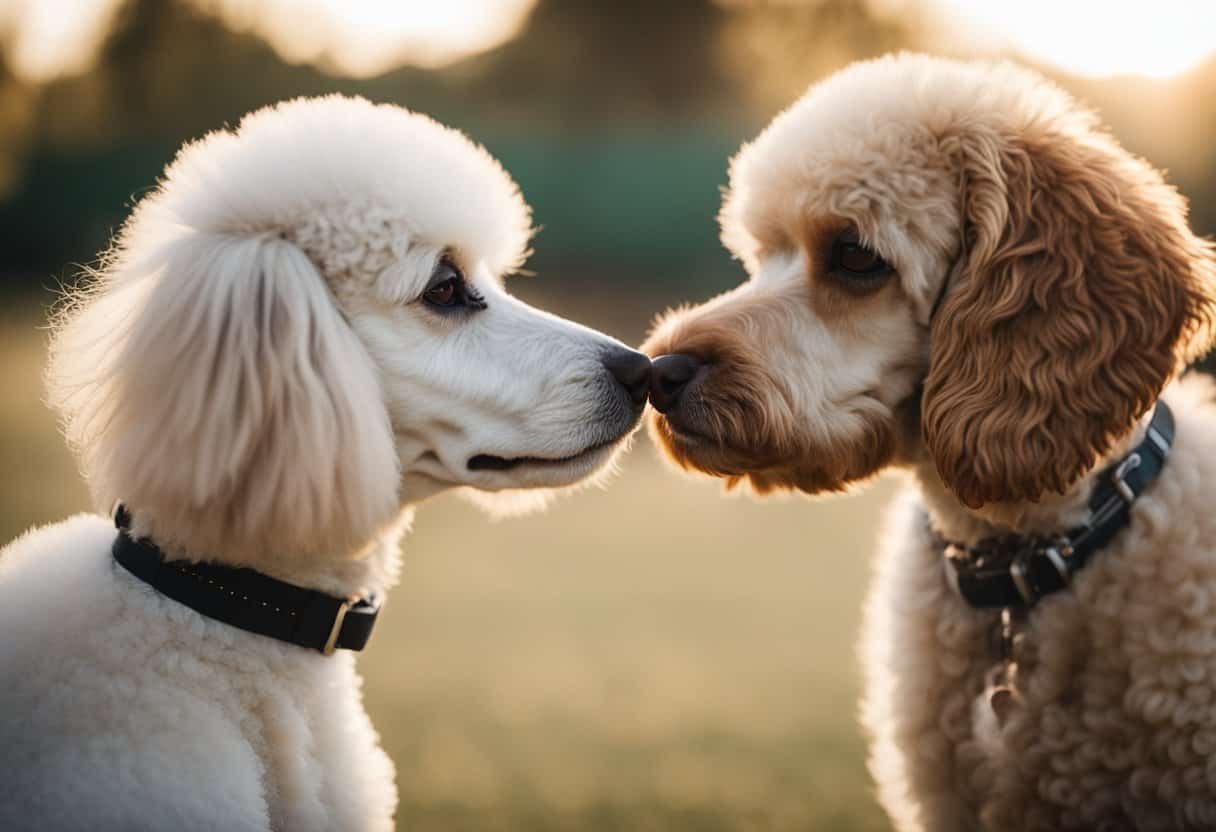
Importance of Cuddles and Leaning
Your poodle’s tendency to cuddle or lean on you isn’t just seeking warmth or comfort—it’s a sign of trust and love.
Cuddles are their way of getting close, showing they feel safe in your arms.
When your poodle leans against you, it’s akin to a hug in dog language, a silent but incredibly strong expression of their affection and reliance on your presence.
Affectionate Belly Rubs and Hugs
The belly is a vulnerable area for dogs, so when your poodle shows their belly, it’s a gesture of submission and trust.
Gentle belly rubs not only feel good to them but also reinforce their confidence in you as their protector and friend.
On the other hand, while not all dogs appreciate hugs, poodles often enjoy this form of physical contact, associating it with love and security from their favorite human.
Communication and Understanding Dog Emotions

Your ability to recognize and correctly interpret your dog’s gestures and emotional states is vital for a strong, empathetic relationship with your canine friend.
Poodles, like all dogs, communicate their emotions through a variety of signals that, when understood, can greatly enhance the bond you share.
Recognizing and Responding to Gestures
Poodles express their feelings through specific body language that includes tail position, ear orientation, and overall body posture.
When your dog is feeling affectionate, they may present a soft, relaxed stance with a gently wagging tail and forward-facing ears.
Responding with positive reinforcement, such as petting or verbal praise, will let your dog know you appreciate their loving gestures.
On the other hand, a tucked tail and lowered body can indicate stress or fear.
In these moments, it is essential to assess the environment for stressors and provide a calming presence. Avoid forcing interaction, as this can exacerbate their anxiety.
If stress behaviors persist, consider consulting a veterinarian to rule out any underlying health issues.
Deciphering Canine Emotional States
Understanding your dog’s emotional state goes beyond gestures; it involves being attentive to subtler signs like facial expressions and vocalizations.
Poodles may communicate happiness with a relaxed, open mouth and a soft gaze, typically accompanied by excited vocalizations or a high-pitched bark. This behavior invites you to share in their joy and engage in playful activities.
Conversely, recognizing signs of discomfort or distress in your poodle can prevent negative experiences.
Growling or snapping should not be punished but rather seen as your dog’s way of saying they need space.
It’s important to recognize these warning signs and respond appropriately by removing them from the uncomfortable situation.
By paying attention to these cues, you are better equipped to understand and enhance your poodle’s overall emotional well-being, ensuring a loving and mutually respectful relationship.
Training and Positive Reinforcement Techniques
Training your Poodle effectively harnesses a bond of love and trust, and the key to unlocking this is through positive reinforcement techniques.
By rewarding desired behaviors, you not only encourage obedience but also foster a deep sense of love and affection between you and your dog.
Reward-Based Training
Positive reinforcement is about rewarding your Poodle for behaviors you want to see more often.
When your Poodle obeys a command or performs a trick correctly, immediately offering a small treat or enthusiastic verbal praise reinforces that behavior.
This method hinges on timing and consistency—rewards must be given promptly to create a clear association. For example:
- Sit: Reward immediately after your Poodle’s hindquarters touch the ground.
- Stay: Provide a treat after your Poodle remains in place for the set time.
- Come: Give affection or a treat every time your Poodle comes when called.
Consistent use of positive reinforcement can significantly enhance training sessions, making them enjoyable and successful.
Teaching Submission and Trust
Submission in the dog world is about trust and respect, not fear.
Teaching submission is crucial for safe and effective training, aiming to establish yourself as a calm and assertive leader.
When your Poodle exhibits submissive behavior, like calmly waiting for food or lying down on command, respond with positive reinforcement. Here’s a structured approach:
- Request a behavior (e.g., “Down”).
- Wait for compliance and a calm submissive state.
- Reinforce with a treat and gentle petting.
Never use force or intimidation; doing so can damage the trust and even the affection your dog has for you.
Instead, strive for mutual respect through consistent, loving guidance. Your Poodle will learn to look to you for cues, feeling secure in the stability you provide.
Love Languages of Dogs
Understanding your dog’s love language enhances the bond you share by recognizing and responding to their unique ways of expressing love and affection.
Gifts and Gestures
Dogs may not be able to wrap presents or create art, but they have their own special gifts and gestures that convey joy and affection.
For many dogs, bringing a favorite toy to you is akin to giving a gift that comes from their heart. They express their joy through wagging tails, excited leaps, and sometimes with a treasured toy as their offering.
It’s important to acknowledge and reciprocate these gestures to reinforce your loving bond.
Interpreting a Dog’s Love Language
Understanding your dog’s love language requires careful observation of their behavior.
Gestures like a soft nuzzle, an eager lick, or a resting head on your lap are clear signs of love and affection your dog is trying to communicate.
When your dog displays these behaviors, they’re revealing what makes them feel loved, and mirroring these actions back can significantly strengthen your relationship.
Consider the ways Poodles show affection and the meaning behind your dog’s love language, as understanding these can help you better cater to their emotional needs.
Frequently Asked Questions
Explore how your Poodle might display their affection, as these intelligent and loving dogs have a variety of ways to communicate love to their owners.
How do you know your Poodle loves you?
Your Poodle may show love through a variety of expressive actions, such as tail wagging, staying close to you, or following you around.
How do Poodles show their affection to owners?
Poodles often express affection physically, favoring cuddles, leaning against you, or resting their head in your lap to show they care.
What actions indicate that a Poodle is feeling affectionate?
Affectionate behaviors in Poodles include bringing toys to you as gifts, gentle nuzzling, or nudging you with their nose, which are signs of their fondness and desire for interaction.
Do Poodles tend to become attached to a single person in the family?
While Poodles form strong bonds with their family, they may often become particularly attached to one individual who they sense understands their needs best or with whom they spend the most time.
What are common behaviors Poodles exhibit when they feel love?
Common love-exhibiting behaviors of Poodles can include tail-wagging, eager licking or kissing, and showing a relaxed, contented body language in your presence.
How can I tell if my Poodle is happy and loving towards me?
Signs that your Poodle is happy and loving towards you include consistent displays of affection. These include excitement when you return home, soft eye contact, and a wiggling rear end. These behaviors demonstrate their joy and trust in your relationship.
.lwrp.link-whisper-related-posts{
margin-top: 40px;
margin-bottom: 30px;
}
.lwrp .lwrp-title{
}.lwrp .lwrp-description{
}
.lwrp .lwrp-list-container{
}
.lwrp .lwrp-list-multi-container{
display: flex;
}
.lwrp .lwrp-list-double{
width: 48%;
}
.lwrp .lwrp-list-triple{
width: 32%;
}
.lwrp .lwrp-list-row-container{
display: flex;
justify-content: space-between;
}
.lwrp .lwrp-list-row-container .lwrp-list-item{
width: calc(25% – 20px);
}
.lwrp .lwrp-list-item:not(.lwrp-no-posts-message-item){
max-width: 150px;
}
.lwrp .lwrp-list-item img{
max-width: 100%;
height: auto;
object-fit: cover;
aspect-ratio: 1 / 1;
}
.lwrp .lwrp-list-item.lwrp-empty-list-item{
background: initial !important;
}
.lwrp .lwrp-list-item .lwrp-list-link .lwrp-list-link-title-text,
.lwrp .lwrp-list-item .lwrp-list-no-posts-message{
}@media screen and (max-width: 480px) {
.lwrp.link-whisper-related-posts{
}
.lwrp .lwrp-title{
}.lwrp .lwrp-description{
}
.lwrp .lwrp-list-multi-container{
flex-direction: column;
}
.lwrp .lwrp-list-multi-container ul.lwrp-list{
margin-top: 0px;
margin-bottom: 0px;
padding-top: 0px;
padding-bottom: 0px;
}
.lwrp .lwrp-list-double,
.lwrp .lwrp-list-triple{
width: 100%;
}
.lwrp .lwrp-list-row-container{
justify-content: initial;
flex-direction: column;
}
.lwrp .lwrp-list-row-container .lwrp-list-item{
width: 100%;
}
.lwrp .lwrp-list-item:not(.lwrp-no-posts-message-item){
max-width: initial;
}
.lwrp .lwrp-list-item .lwrp-list-link .lwrp-list-link-title-text,
.lwrp .lwrp-list-item .lwrp-list-no-posts-message{
};
}
Ready to Adopt a Poodle?
Find poodle rescues and adoption organizations near you. Give a loving poodle their forever home.
.lwrp.link-whisper-related-posts{
margin-top: 40px;
margin-bottom: 30px;
}
.lwrp .lwrp-title{
}.lwrp .lwrp-description{
}
.lwrp .lwrp-list-container{
}
.lwrp .lwrp-list-multi-container{
display: flex;
}
.lwrp .lwrp-list-double{
width: 48%;
}
.lwrp .lwrp-list-triple{
width: 32%;
}
.lwrp .lwrp-list-row-container{
display: flex;
justify-content: space-between;
}
.lwrp .lwrp-list-row-container .lwrp-list-item{
width: calc(25% – 20px);
}
.lwrp .lwrp-list-item:not(.lwrp-no-posts-message-item){
max-width: 150px;
}
.lwrp .lwrp-list-item img{
max-width: 100%;
height: auto;
object-fit: cover;
aspect-ratio: 1 / 1;
}
.lwrp .lwrp-list-item.lwrp-empty-list-item{
background: initial !important;
}
.lwrp .lwrp-list-item .lwrp-list-link .lwrp-list-link-title-text,
.lwrp .lwrp-list-item .lwrp-list-no-posts-message{
}@media screen and (max-width: 480px) {
.lwrp.link-whisper-related-posts{
}
.lwrp .lwrp-title{
}.lwrp .lwrp-description{
}
.lwrp .lwrp-list-multi-container{
flex-direction: column;
}
.lwrp .lwrp-list-multi-container ul.lwrp-list{
margin-top: 0px;
margin-bottom: 0px;
padding-top: 0px;
padding-bottom: 0px;
}
.lwrp .lwrp-list-double,
.lwrp .lwrp-list-triple{
width: 100%;
}
.lwrp .lwrp-list-row-container{
justify-content: initial;
flex-direction: column;
}
.lwrp .lwrp-list-row-container .lwrp-list-item{
width: 100%;
}
.lwrp .lwrp-list-item:not(.lwrp-no-posts-message-item){
max-width: initial;
}
.lwrp .lwrp-list-item .lwrp-list-link .lwrp-list-link-title-text,
.lwrp .lwrp-list-item .lwrp-list-no-posts-message{
};
}


